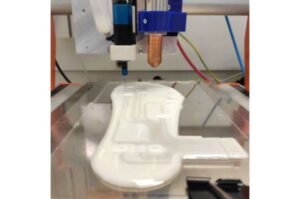Researchers develop 3D printed sensor embedded silicone insoles
Zurich, Switzerland – Researchers at ETH Zurich, Empa and EPFL are developing a 3D-printed insole with integrated sensors that allows the pressure of the sole to be measured in the shoe and thus during any activity. This helps athletes or patients to determine performance and therapy progress.
In elite sports, fractions of a second sometimes make the difference between victory and defeat. To optimize their performance, athletes use custom-made insoles. But people with musculoskeletal pain also turn to insoles to combat their discomfort.
Before specialists can accurately fit such insoles, they must first create a pressure profile of the feet. To this end, athletes or patients have to walk barefoot over pressure-sensitive mats, where they leave their individual footprints. Based on this pressure profile, orthopedists then create customized insoles by hand. The problem with this approach is that optimizations and adjustments take time. Another disadvantage is that the pressure-sensitive mats allow measurements only in a confined space, but not during workouts or outdoor activities.
Now an invention by a research team from ETH Zurich, Empa and EPFL could greatly improve things. The researchers used 3D printing to produce a customized insole with integrated pressure sensors that can measure the pressure on the sole of the foot directly in the shoe during various activities.
“You can tell from the pressure patterns detected whether someone is walking, running, climbing stairs, or even carrying a heavy load on their back—in which case the pressure shifts more to the heel,” explains co-project leader Gilberto Siqueira, Senior Assistant at Empa and at ETH Complex Materials Laboratory. This makes tedious mat tests a thing of the past. The invention was recently featured in the journal Scientific Reports.
These insoles aren’t just easy to use, they’re also easy to make. They are produced in just one step—including the integrated sensors and conductors—using a single 3D printer, called an extruder.
For printing, the researchers use various inks developed specifically for this application. As the basis for the insole, the materials scientists use a mixture of silicone and cellulose nanoparticles.
Next, they print the conductors on this first layer using a conductive ink containing silver. They then print the sensors on the conductors in individual places using ink that contains carbon black. The sensors aren’t distributed at random: they are placed exactly where the foot sole pressure is greatest. To protect the sensors and conductors, the researchers coat them with another layer of silicone.
An initial difficulty was to achieve good adhesion between the different material layers. The researchers resolved this by treating the surface of the silicone layers with hot plasma.

